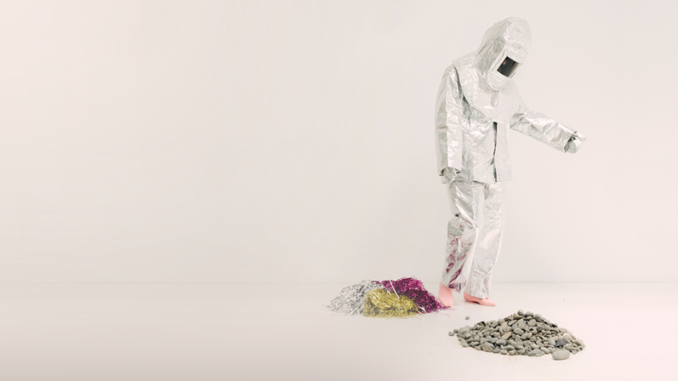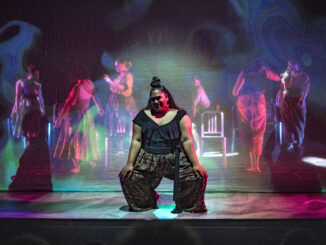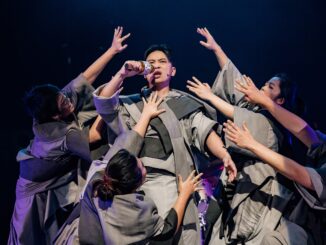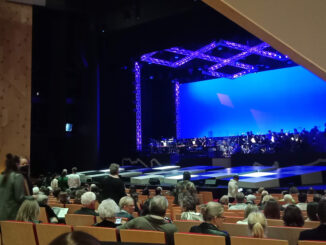
Yesterday I launched a new timeline feature tracking the impact of Covid-19 on Aotearoa New Zealand theatre and performance from 2020 till today.
One major milestone was on 13th April 2022, when the country moved into the Orange traffic light setting. For the first time in months (and many months in Auckland’s case), live performance can go ahead without any capacity limitations.
But that amber glow hasn’t quite offered the relief that it seems to promise. With Government health measures lifting, but Covid continuing to spread in the community, it is a confusing and uncertain time for practitioners and audiences. While some major changes have been introduced, in other ways, Orange so far hasn’t looked much different to Red.
Here’s my analysis of the current state of play for Aotearoa’s live performance sector under Orange.
Gathering restrictions have lifted
Under the red traffic light setting, venue numbers were initially capped at 100 attendees. This meant it wasn’t feasible for many shows in larger venues to open, while smaller venues still had to reduce capacity due to the 1m distancing requirements. On 25th March the maximum indoor capacity under Red was raised to 200 and outdoor limits were removed, but this didn’t offer much of a tangible change for live performance. As Silo Theatre artistic director Sophie Roberts said, “a change in rules doesn’t mean the way people feel about going out and gathering right now will also change overnight and that will take time to rebuild.” When New Zealand moved to Orange on 13th April 2022, all gathering restrictions were lifted.
This means venues are back to their full capacity – in theory. The reality demonstrates that it is not the public health measures that are limiting audience numbers for live performance, but the virus itself (this has also played out in the hospitality sector). Where I live in Wellington, ticket sales have been sluggish and few shows are selling out. As well people who are cautious to come to the theatre, some of your potential audience in a given week could also be isolating as a positive case or household contact. Manatū Taonga Ministry of Culture and Heritage project that audiences could be down during the first six weeks after the move to orange – the question is whether this audience reluctance will extend even longer.
Vaccine passes are out
On the 4th April 2022 the Government removed the requirement for vaccine passes to be used at events (or other businesses), and it became the decision of individual events and businesses to continue using them or not. Most venues, including BATS Theatre in Wellington, Little Andromeda in Christchurch and Auckland Live and Auckland Theatre Company quickly dropped passes. Auckland Theatre Company’s Jonathan Bielski told The Spinoff that “I think there’s a mood for people to be able to come to the theatre without needing to show their vaccine pass” and Little Andromeda’s Michael Bell explained that “there wasn’t any energy coming from anywhere to keep doing vax passes.”
None of our theatres have come out strongly in support of keeping vaccine passes. Auckland’s Basement Theatre (which has been holding outdoor performances only) is currently requiring vaccine passes but reviewing the policy with an update scheduled for 10th May.
Broadway’s theatres, which had been dealing with Omicron for over a month longer than New Zealand, only dropped their pass requirements on April 30th. Our venues could have made the argument for retaining passes for longer during at least the initial stages of Orange as a way to provide some further safety assurance for prospective audiences, especially since Red’s 1m physical distancing is gone (it’s going to take some time to get used to sitting so close to people again!). Unvaccinated people are still 3.1x more likely to pass on the virus. While the removal of passes will have allowed some unvaccinated people to return to the theatre after many months, the flipside is that it will have made others less likely to visit the theatre.
Q Theatre has decided not to continue using passes, but gives the option for individual shows to choose to use them. The Terrapolis team (finally opening in April 2022 after the original season dates were cancelled last year due to Delta) opted to use vaccine passes. Flexibility is good, but this kind of arrangement does place the burden of responsibility on production teams.
Audiences are masked up (mostly)
Under Orange, masks are one of the few remaining public health measures. We know that we are safest when everyone is wearing a mask. The Government’s framework encourages mask wearing at events under Oranges. A number of venues require audiences to mask up. Circa Theatre for example states that “masks will be worn by audiences and staff under all Traffic Light settings.”
Enforcing this policy is a different matter. Masks can be removed to eat and drink, and I’ve often seen masks subsequently stay off the rest of the show at a number of different venues. While acknowledging that some people will have a legitimate mask exemption, it can be worrying when people around you in the theatre aren’t masked. In my first visit to a theatre under Orange, my seats were next to a group who weren’t wearing masks. I ignored the seat number on my ticket and sat somewhere else (possible due to the small audience that night). I know that I would have felt incredibly uncomfortable if I’d had no choice about sitting next to this group, and I don’t know if I would have been able to stay for the performance.
Auckland Live’s Covid-19 FAQ reveals the advice that “we recommend you wear a face mask; however, it is not a requirement.” It is surprising that Auckland Live, which runs premiere venues including the Aotea Centre and the Civic Theatre and is part of Auckland Council Organisation Auckland Unlimited, isn’t taking a stronger stand on masks given evidence around its efficacy. Broadway is retaining strict audience masking through to at least the end of May. Masking is a small trade off for being able to go to the theatre and make it safer for everyone.
Prospective audiences will do their own risk assessments
Some people will want to live their lives as before the pandemic, and are less concerned about contracting the virus. Others, like me, want to be cautious and will be doing careful assessments about the level of risk we’re prepared to place ourselves in. With the Government removing public health measures, the onus is mostly on individuals to make their own calls.
I usually go to multiple shows a week. Certainly, there is less on at the moment (RIP Comedy Festival), but I’m still having to think very carefully about whether I’m prepared to up my risk by being in certain environments. Often, it’s not worth it. Even though I’m a proud theatre fanatic, I’ve drastically reduced my theatre intake.
There are some venues in Wellington I stopped going to during NZ Fringe in early March because I felt unsafe (the Fringe took place during the height of the Omicron peak, one of the few performance festivals to go ahead during this period). These were smaller venues where the majority of the audience went unmasked; the audience would eat, drink, laugh and even sing-along with the performers (a risk factor for Covid spread). While allowed under the settings, this was hardly a safety-first approach. I don’t know when I’ll be ready to return to such venues.
We need live performance. Its good for our wellbeing and social connection. We want artists to be able to continue their practice and to sustain their careers. At the same time, we should be doing everything that we can to protect audiences, performers, crew and venue workers. This makes public health and financial sense – give your audiences confidence to come out to the show and retain their patron.
Who isn’t going to the theatre in Orange? Theatres have never been a good space for immunocompromised and disabled people, but right now they are especially not. Actor Liz Carr has warned that UK theatres were becoming inaccessible to people with underlying health conditions due to the falling number of people wearing masks. Carr advocates for designated “safer” performances with reduced capacity and mandatory masking, stating that “every show should be doing that to make sure theatre remains accessible even to those of us who have health conditions.” She also spoke about the value of online performance, “don’t forget there are a whole bunch of people who still can’t access the theatre, let’s not forget about them.”
Covid is still disrupting shows
Who says the pandemic is behind us? While Orange means a show can play without capacity restrictions, Orange is no guarantee that a show’s season will go on as intended. One of the gutting features of this current period of the outbreak is that there are shows that are cancelling or closing early due to cast and crew contracting the virus or becoming household contacts. This was happening thick and fast during the NZ Fringe, during which I experienced a fair amount of ‘cancellation fatigue’ – in this final week it felt like a miracle when any show was able to make it through another night without a team member needing to go into isolation. Recently at Wellington’s BATS Theatre, Undoing, which opened April 6th, only made it through its first shows before closing. Mokomoko (already rescheduled from dates earlier this year) has cancelled its opening performances this week and truncated its season. Meanwhile, Christchurch’s Little Andromeda has juggled several postponements over the past month. With the continued high prevalence of Covid in the community, it still feels a bit of a lottery whether a show will be able to make it through its entire season.
NZ performers are touring internationally again
Another recent milestone on the Aotearoa New Zealand Theatre and Covid-19 timeline was Indian Ink Theatre Company undertaking its first international tour since our borders first closed in March 2020. Indian Ink opened Paradise or the Impermanence of Ice Cream at the Maui Arts and Culture Center’s Castle Theatre on 26th March as part of a tour to four of the Hawaiian Islands and Arizona, USA.
Chris Parker and A Slightly Isolated Dog Theatre Company were part of a contingent of New Zealand performers playing at the Melbourne International Comedy Festival in March/April. Urzila Carlson took out the people’s choice award for most popular show of the festival (based on ticket sales). While not without its risks (17% of the Melbourne’s International Comedy Festival were forced to cancel some shows due to Covid isolation), the end of managed isolation for NZ travelers has made overseas gigs possible again for some artists.
International acts are also coming here, crowding the market
Of course, that goes the other way as well – the staggered opening of the border means a cavalcade of international acts is heading our way. The Australian production of The Wedding Singer musical (trying again after a cancelled tour last year) is playing Auckland and Wellington. There’s big music acts like Billie Eilish and Harry Styles. We even seem to be hosting an unofficial British Comedy Festival, with top acts like Alan Carr, Sarah Millican, Nigel Ng and Rob Beckett all announcing upcoming dates.
We celebrated our local artists while borders were shut (at least in the periods when live performance could go ahead), but now the attention is swinging back to international acts. They have the resources and backing to book up these dates. It is good news for our venues, who have had to weather long periods with cancellations and reduced bookings. But it adds to the challenges facing our local practitioners. With the cost of living crisis reducing disposable income, will our audiences preference these big name international events?
Manatū Taonga support schemes have been a lifeline, with fishhooks
Aotearoa’s theatre and performance sector has been protected from collapse during the Omicron outbreak by Manatū Taonga Ministry of Culture and Heritage’s support schemes, with the Government announcing on February 2nd $121 million in new spending for arts and culture sector to get through the Omicron outbreak. Eligibility for MCH’s Arts and Culture Event Support Scheme was expanded to financially cover registered events (with a capacity of between 100-5000) that had to cancel due to the Red Traffic light setting or a lead performer being required to isolate, as well as shows continuing under reduced capacity. As of May 2nd, $18.7 million of payments have been approved. These payments go to event organisers to cover non-recoverable losses, and full payment to artists and production crew is a condition of the payment. As an example, the NZ International Comedy Festival is one of the registered events, which means that all comedians and crew who had been set to work the cancelled festival are able to be paid what they (generally) would have received if the Festival had been able to go ahead. This is a significant help over a period which has featured widespread event cancellations and loss of income for arts and culture workers.
Full disclosure – my company Theatre of Love has been paid as part of the scheme, and it is a relief to have the funds to pay people for the cancelled season of our show. While the budget template wasn’t intuitive, we found the process relatively painless, and the payment came quickly once everything was in.
The fishhook: the scheme relies on event organisers to register for the scheme, get the paper work in, and then distribute fees to artists and crew in a timely manner. If the event organiser doesn’t do this, then everyone else involved in the cancelled event misses out.
MCH’s Support for Self-Employed Individuals in the Arts, Culture and Heritage Sector of a one-off grant of $5000 was therefore a welcome initiative, offering direct payment to people whose income was directly affected by the move to the Red setting. People who had lost income urgently needed this support, but it wasn’t till the end of February that people were able to apply for the scheme – MCH worked at speed, but still had to design the whole system essentially from scratch. With the shift to Orange, tomorrow (5th May) is the last day new applications will be accepted.
Manatū Taonga’s current criteria assumes that work opportunities and audience numbers will stabilise under the Orange traffic light setting. The Event Support Scheme covers organisers for unrecoverable losses incurred due to reduced audience attendance during the first six weeks after a move to Orange. After that, it only kicks in for registered events that incur costs due to their lead performer(s) being required to isolate.
It is an optimistic view that audience numbers will return to ‘normal’ under Orange, especially with the added cost of living pressures. As long as there is a disjuncture between the Government’s public health settings and our case numbers, hospitalisations and mortality rate, then some individuals will continue to take their own personal precautions.
The coming months could be tough
Experts warn to prepare for a new Covid wave over winter, and the winter flu could also be a spoiler.
It’s a tough time to be doing live performance – hoping you will make it to opening without a team member testing positive, and hoping that there will be audiences to play to.
One comfort is that MCH’s Event Support Scheme is in place to cover losses if the Government moves us back up to the Red setting, or if a lead performer isolates (up to 31 January 2023).
But there could be a difficult period after the first 6 weeks of Orange from 25th May if we remain in Orange but cases and hospitalisations remain high or start to increase again, and consequently audience numbers don’t recover.
With the support mechanisms all now in place, MCH should now have the ability to respond more quickly to actual conditions – and be prepared to extend support through Orange as needed.
Time to mask up.




Leave a Reply